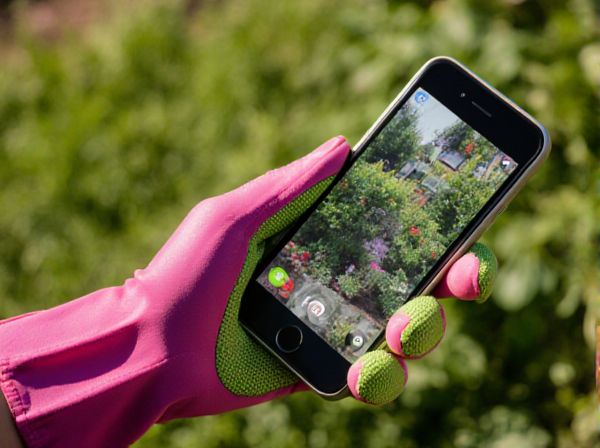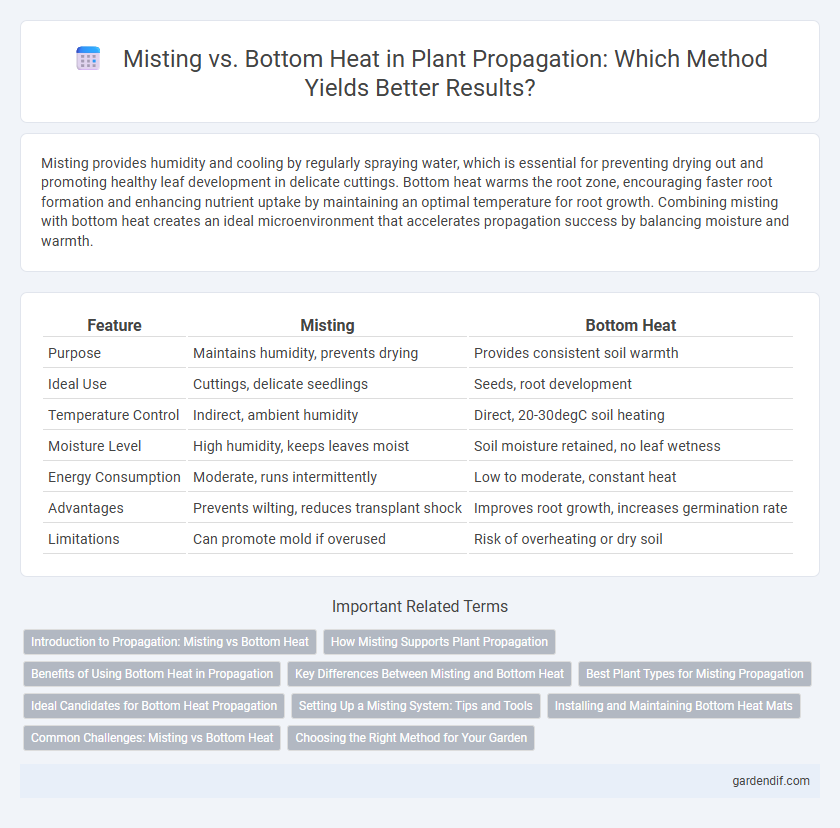
Misting vs bottom heat Illustration
Misting provides humidity and cooling by regularly spraying water, which is essential for preventing drying out and promoting healthy leaf development in delicate cuttings. Bottom heat warms the root zone, encouraging faster root formation and enhancing nutrient uptake by maintaining an optimal temperature for root growth. Combining misting with bottom heat creates an ideal microenvironment that accelerates propagation success by balancing moisture and warmth.
Table of Comparison
| Feature | Misting | Bottom Heat |
|---|---|---|
| Purpose | Maintains humidity, prevents drying | Provides consistent soil warmth |
| Ideal Use | Cuttings, delicate seedlings | Seeds, root development |
| Temperature Control | Indirect, ambient humidity | Direct, 20-30degC soil heating |
| Moisture Level | High humidity, keeps leaves moist | Soil moisture retained, no leaf wetness |
| Energy Consumption | Moderate, runs intermittently | Low to moderate, constant heat |
| Advantages | Prevents wilting, reduces transplant shock | Improves root growth, increases germination rate |
| Limitations | Can promote mold if overused | Risk of overheating or dry soil |
Introduction to Propagation: Misting vs Bottom Heat
Misting and bottom heat are essential techniques in plant propagation, each promoting root development under specific conditions. Misting maintains high humidity by spraying fine water droplets, reducing water loss and preventing wilting in cuttings. Bottom heat gently warms the soil or rooting medium, accelerating root growth and enhancing nutrient uptake in cooler environments.
How Misting Supports Plant Propagation
Misting enhances plant propagation by maintaining consistent humidity levels, which reduces transpiration stress and promotes root development. This moisture-rich environment supports the survival of cuttings and delicate seedlings by preventing dehydration. Compared to bottom heat, misting directly addresses aerial moisture needs, crucial for species that rely on high humidity for successful propagation.
Benefits of Using Bottom Heat in Propagation
Using bottom heat in propagation enhances root development by maintaining consistent soil temperatures, which accelerates seed germination and cutting establishment. It promotes stronger, more resilient seedlings by stimulating enzymatic activity and improving nutrient uptake. Bottom heat also reduces the risk of damping-off disease by creating a warm, dry surface environment unfavorable to pathogens.
Key Differences Between Misting and Bottom Heat
Misting provides high humidity and cooling by delivering fine water droplets to the plant surface, which is essential for preventing desiccation in delicate cuttings during propagation. Bottom heat, on the other hand, supplies consistent warmth through heating mats or cables beneath seed trays, promoting root development and faster germination. Misting controls moisture levels in the air, while bottom heat directly influences soil temperature, making both techniques complementary but functionally distinct for successful propagation.
Best Plant Types for Misting Propagation
Misting propagation is ideal for delicate plants such as ferns, orchids, and African violets that require high humidity and consistent moisture to develop roots. These species thrive with gentle, frequent water droplets that prevent drying without oversaturating the medium. Unlike bottom heat, misting supports the propagation of humidity-loving plants by maintaining a moist environment crucial for their successful rooting.
Ideal Candidates for Bottom Heat Propagation
Ideal candidates for bottom heat propagation include heat-loving seeds such as peppers, tomatoes, and eggplants that require soil temperatures between 70degF to 85degF for optimal germination. These plants benefit from consistent warmth provided by bottom heat, which accelerates root development and enhances seedling vigor. Bottom heat is also effective for rooting cuttings of tropical and subtropical species that thrive in stable, warm soil conditions.
Setting Up a Misting System: Tips and Tools
Setting up a misting system for propagation requires selecting adjustable mist nozzles to ensure fine water droplets that maintain consistent humidity without saturating the soil. Incorporate a timer to regulate mist intervals, promoting optimal moisture levels and reducing fungal risks commonly associated with bottom heat setups. Use a waterproof reservoir and durable tubing to streamline the system's efficiency, improving cutting success rates during propagation.
Installing and Maintaining Bottom Heat Mats
Installing bottom heat mats involves placing the mat beneath propagation trays to provide consistent warmth, which stimulates root development and speeds up seed germination. Maintaining these mats requires regular temperature monitoring, ensuring they stay within the optimal range of 70-85degF (21-29degC) to avoid overheating or insufficient heat. Proper cleaning and checking electrical connections before and after each use prolongs the lifespan and efficiency of bottom heat mats in propagation setups.
Common Challenges: Misting vs Bottom Heat
Common challenges in propagation include maintaining optimal humidity levels with misting systems, which can cause fungal diseases if overused, while bottom heat risks soil overheating and root damage if not properly regulated. Misting requires precise timing to avoid waterlogging, whereas bottom heat demands consistent temperature control to promote seed germination without drying out the medium. Balancing moisture and temperature is crucial to prevent seedling stress and ensure successful propagation.
Choosing the Right Method for Your Garden
Misting systems provide consistent humidity ideal for seed germination and delicate cuttings, while bottom heat promotes root development by warming soil or propagation trays. Selecting the right propagation method depends on plant species, environmental conditions, and desired growth speed. Combining misting with bottom heat often yields optimal results, enhancing both moisture retention and root establishment.
Misting vs bottom heat Infographic

 gardendif.com
gardendif.com